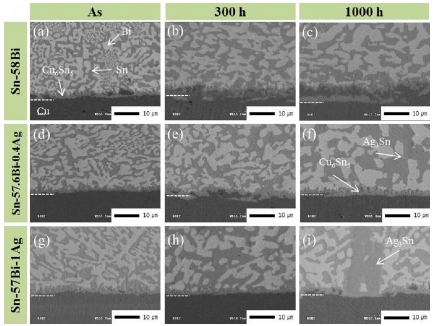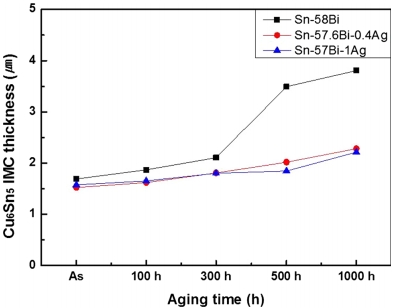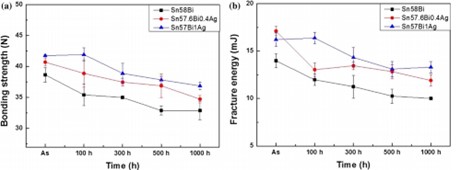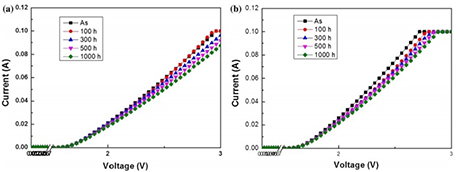The Effect of Ag Content on the Reliability of SnBi Solder LED Package_Shenzhen Fitech

The Effect of Ag Content on the Reliability of SnBi Solder LED Package
Light-emitting diodes (LEDs), as a new type of lighting and display technology with high efficiency, small size, long life and low power consumption, are widely used in a variety of fields such as household lighting, automotive indicator lights, avionics and display backlighting units, etc. The development of LED technology requires the realization of high power densities and high-temperature capabilities. However, only 20-30% of the electrical energy of high-power LEDs is converted into light energy, and the rest of the electrical energy is dissipated as heat, leading to overheating of the LED chip and affecting its lifetime. Therefore, the luminous efficiency and lifetime of LED are closely related to the junction temperature, and the operating temperature is a key factor in determining its reliability and durability. In addition, high temperature will also bring huge thermal stress to the material.
The reliability of the LED package directly determines its luminous efficiency, life and stability. This reliability mainly depends on the performance of the solder, because the solder is an important material connecting the LED chip and PCB, and needs to withstand the thermal stress, electrical stress and mechanical stress when the LED works. In the past, the commonly used solder material is SnPb alloy, but because it contains toxic Pb elements, does not meet the environmental requirements, so the need to find alternatives. Currently, the industry's more recognized lead-free solder is represented by SnAg3Cu0.5, but its melting point is high, resulting in increased assembly temperature, and higher requirements for the temperature resistance of components and substrates.SnBi alloy is a low melting point, low-cost, low-toxicity solder material with certain application potential, but its mechanical and electrical properties are poor, and need to be improved by adding other elements. Ag is a commonly used additive element to improve the melting point, strength and electrical conductivity of the solder, but it also increases the cost and brittleness of the solder. Therefore, it is important to study the effect of adding Ag on the reliability of SnBiAg solder in LED packages to optimize the performance of the solder and select the appropriate solder ratio.

Figure 1. SMD surface mount LED package structure.
In order to investigate the effect of added Ag on the reliability of LED packages with SnBiAg solder, Myung et al. used three types of solder, SnBi58, SnBi57.6Ag0.4, and SnBi57Ag1 to package and connect the LED components to PCBs with Cu pads having OSP surface treatments, and then carried out aging tests at 85°C for 100, 300, 500, and 1000h aging tests, the shear strength and current-voltage characteristics of the solder joints were tested, and the microstructure and composition of the solder joints were observed and analyzed, respectively.
The microstructure of the solder joints directly affects the mechanical and electrical properties of the solder joints, which mainly depends on the composition of the solder, the melting and solidification process, the interfacial reaction and the aging conditions. Figure 2 shows the SEM photos of the solder joints after aging at 85°C. A Cu6Sn5 IMC layer was formed after reflow soldering. In the SnBi57.6Ag4 solder, Ag3Sn particles smaller than 1 μm were present, while the addition of 1% Ag to the SnBi solder resulted in the formation of large Ag3Sn IMC on the Cu6Sn5 layer.

Fig. 2. Cross-sectional SEM micrographs of solder joints with different aging times.
The thickness of the IMC layer has an important effect on the reliability of the solder joints, and in general, an excessively thick IMC layer increases the brittleness and stress concentration of the solder joints, leading to the failure of the solder joints. Figure 3 shows the variation of CuSn65 IMC thickness with aging time. After aging for 300 hours, the Cu6Sn5 IMC thickness of SnBi58 solder is significantly higher than that of SnBi57.6Ag0.4 and SnBi57Ag1 solder. This is due to the fact that the Ag added in the solder reacted with Sn to form Ag3Sn IMC, which consumed the Sn in the solder matrix, and thus Cu did not react sufficiently with Sn resulting in a relatively lower IMC thickness than that of the SnBi58 solder.

Figure 3. IMC thickness in soldered joints as a function of aging time.
Figure 4 shows the effect of thermal aging for different times on the bond strength and fracture properties. Both bond strength and fracture properties decrease with increasing aging time, which may be due to the growth of the Cu6Sn5 IMC layer and the coarsening of the Sn-rich and Bismuth-rich phases with increasing aging time. Higher values of bond strength and fracture properties, i.e., higher reliability of the solder joints, were obtained at 1 wt% Ag content.

Fig. 4. Bond strength (a) and fracture properties (b) of solder joints with different solder alloy compositions.
Figure 5 shows the LED package I-V curve versus aging time. Calculating the solder joint resistance by the slope, the difference between SnBi58 and SnBi57Ag1 solder joint resistance is about 4% after adding Ag. However, with the increase in aging time leading to IMC layer growth, the SnBi58 and SnBi57Ag1 solder joint resistance increased by 3.4% and 2.2%, respectively, i.e., the resistivity of the solder joints increased with the increase in aging time. The resistivity of the solder joints has an important effect on the performance of the LED package, and in general, the lower the resistivity, the better the conductivity of the solder joints and the better the performance of the LED package.

Figure 5. I-V curves versus aging time for LED packages; a SnBi58 and b SnBi57Ag1 solder joints.
Shenzhen Fitech has professional experience in R&D and production of solder paste, its solder paste products have excellent printability, stable mechanical and electrical properties and excellent wettability, particle size model covers T6-T9, and has been verified and used by many customers. Welcome to contact us for more product information.
Myung, W.-R., Ko, M.-K., Kim, Y., & Jung, S.-B. (2015). Effects of Ag content on the reliability of LED package component with Sn–Bi–Ag solder. Journal of Materials Science: Materials in Electronics, 26(11), 8707–8713. doi:10.1007/s10854-015-3546-6

















 Back to list
Back to list



